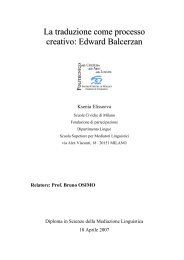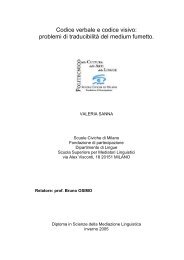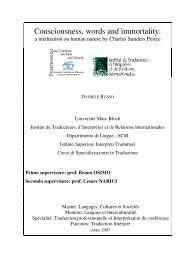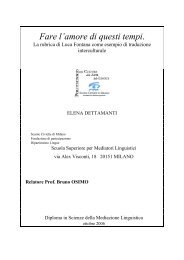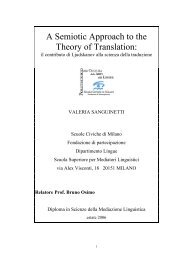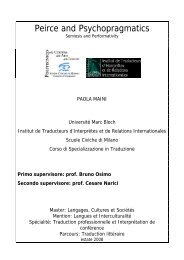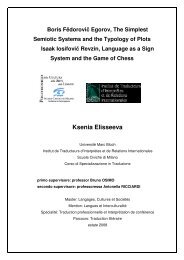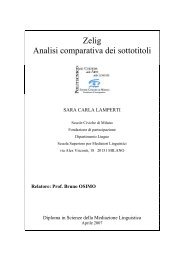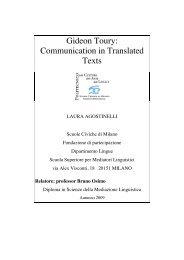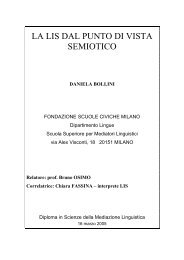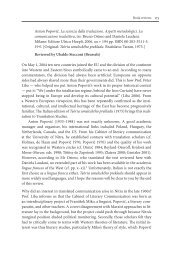Alice in Wonderland - Bruno Osimo, traduzioni, semiotica della ...
Alice in Wonderland - Bruno Osimo, traduzioni, semiotica della ...
Alice in Wonderland - Bruno Osimo, traduzioni, semiotica della ...
Create successful ePaper yourself
Turn your PDF publications into a flip-book with our unique Google optimized e-Paper software.
children, they have been published <strong>in</strong> children’s books series. REM and BUB<br />
have new illustrations, the ones <strong>in</strong> BUB follow<strong>in</strong>g Tenniel’s footsteps, the<br />
ones <strong>in</strong> REM show<strong>in</strong>g a rather modern <strong>Alice</strong> <strong>in</strong> m<strong>in</strong>i-skirt and ponytail. TEU<br />
reproduces the orig<strong>in</strong>al illustrations by John Tenniel. ENZ also uses the<br />
Tenniel pictures, but the publication of the book <strong>in</strong> the prestigious Insel<br />
Verlag po<strong>in</strong>ts to an adult audience.<br />
A quantitative analysis of translation procedures shows the follow<strong>in</strong>g results.<br />
The reproduction of source-language names without any changes <strong>in</strong> the<br />
form (repro), although usually with an adaptation of the pronunciation to<br />
target-language norms, is the most frequently used technique <strong>in</strong> DE-BUB<br />
(38%), DE-REM and FR (both 48%) as well as IT (55%). The use of<br />
adaptation of source-cultural names to target-language morphology (adapt)<br />
and of exonyms (exonym) is most frequent <strong>in</strong> the Spanish translation (ES,<br />
together 58.6%), which confirms the assumption that the adaptation of<br />
proper names is conventional <strong>in</strong> Spanish literature. The substitution of<br />
source-culture names by target culture names (subst) is the favourite<br />
procedure <strong>in</strong> DE-ENZ (44.8%). Together with the proper names rendered as<br />
generic nouns, which also has an adapt<strong>in</strong>g effect, substitutions sum up to<br />
65.5% <strong>in</strong> DE-ENZ. As we have seen before, the Brazilian translator has left<br />
out a large number (38%) of the proper names and substituted another<br />
31%, which makes her translation the most target-oriented of our corpus.<br />
Actually, on the front page of the book, the text is characterized as an<br />
“adaptação.” The only translator who has no real “favourite” technique is<br />
DE-TEU, but adaptations, substitutions and translation by generic nouns<br />
represent 62% of her procedures. Therefore, her translation also has a<br />
strong target-orientation.<br />
63



